Enhancing the Gamma-Radiation-Shielding Properties of Gypsum–Lime–Waste Marble Mortars by Incorporating Micro- and Nano-PbO Particles
Abstract
:1. Introduction
2. Materials and Methods
2.1. Materials
2.2. Mixture Processing
2.3. Gamma Attenuation Measurements
2.4. Theoretical Calculations
3. Results and Discussion
3.1. Microstructural Characterization
3.2. Gamma-Ray-Shielding Characteristics
4. Conclusions
Author Contributions
Funding
Institutional Review Board Statement
Informed Consent Statement
Data Availability Statement
Conflicts of Interest
References
- Alabsy, M.T.; Alzahrani, J.S.; Sayyed, M.I.; Abbas, M.I.; Tishkevich, D.I.; El-Khatib, A.M.; Elsafi, M. Gamma-Ray Attenuation and Exposure Buildup Factor of Novel Polymers in Shielding Using Geant4 Simulation. Materials 2021, 14, 5051. [Google Scholar] [CrossRef] [PubMed]
- Elgazzar, A.H.; Kazem, N. The Pathophysiologic Basis of Nuclear Medicine. In Biological Effects of Ionizing Radiation; Springer: Berlin/Heidelberg, Germany, 2015; pp. 715–726. [Google Scholar]
- Kalkornsuranee, E.; Intom, S.; Lehman, N.; Johns, J.; Kothan, S.; Sengloyluan, K.; Chaiphaksa, W.; Kaewkhao, J. Mechanical and gamma radiation shielding properties of natural rubber composites: Effects of bismuth oxide (Bi2O3) and lead oxide (PbO). Mater. Res. Innov. 2022, 26, 8–15. [Google Scholar] [CrossRef]
- Martin, A.; Harbison, S.; Beach, K.; Cole, P. An Introduction to Radiation Protection; CRC Press: Boca Raton, FL, USA, 2018. [Google Scholar]
- Sayyed, M.I.; Almousa, N.; Elsafi, M. Preparation of Mortar with Fe2O3 Nanoparticles for Radiation Shielding Application. Coatings 2022, 12, 1329. [Google Scholar] [CrossRef]
- Günoğlu, K. Radiation Transmission of Some Gypsum Concretes for 511, 835 and 1275 keV Gamma Rays. Acta Phys. Pol. A 2017, 132, 1022–1024. [Google Scholar] [CrossRef]
- Tekin, H.O.; Singh, V.P.; Manici, T.; Altunsoy, E.E. Validation of MCNPX with experimental results of mass attenuation coefficients for cement, gypsum and mixture. J. Radiat. Prot. Res. 2017, 42, 154–157. [Google Scholar] [CrossRef]
- Sidhu, B.S.; Dhaliwal, A.S.; Kahlon, K.S.; Singh, S. On the use of flyash-lime-gypsum (FaLG) bricks in the storage facilities for low level nuclear waste. Nucl. Eng. Technol. 2022, 54, 674–680. [Google Scholar] [CrossRef]
- Ural, N.; Yakşe, G. Utilization of marble piece wastes as base materials. Open Geosci. 2020, 12, 1247–1262. [Google Scholar] [CrossRef]
- Sufian, M.; Ullah, S.; Ostrowski, K.A.; Ahmad, A.; Zia, A.; Śliwa-Wieczorek, K.; Siddiq, M.; Awan, A.A. An experimental and empirical study on the use of waste marble powder in construction material. Materials 2021, 14, 3829. [Google Scholar] [CrossRef] [PubMed]
- Kore, S.D.; Vyas, A.K. Impact of marble waste as coarse aggregate on properties of lean cement concrete. Case Stud. Constr. Mater. 2016, 4, 85–92. [Google Scholar] [CrossRef]
- Cinan, Z.M.; Baskan, T.; Erol, B.; Mutlu, S.; Misirlioglu, Y.; Yilmaz, S.S.; Yilmaz, A.H. Gamma irradiation, thermal conductivity, and phase change tests of the cement-hyperbranched poly amino-ester-block-poly cabrolactone-polyurathane plaster-lead oxide and arsenic oxide composite for development of radiation shielding material. Int. J. Energy Res. 2021, 45, 20729–20762. [Google Scholar] [CrossRef]
- El-Khatib, A.M.; Shalaby, T.I.; Antar, A.; Elsafi, M. Improving Gamma Ray Shielding Behaviors of Polypropylene Using PbO Nanoparticles: An Experimental Study. Materials 2022, 15, 3908. [Google Scholar] [CrossRef] [PubMed]
- Mahmoud, M.E.; El-Khatib, A.M.; Badawi, M.S.; Rashad, A.R.; El-Sharkawy, R.M.; Thabet, A.A. Recycled high-density polyethylene plastics added with lead oxide nanoparticles as sustainable radiation shielding materials. J. Clean. Prod. 2018, 176, 276–287. [Google Scholar] [CrossRef]
- Sabri, J.H.; Mahdi, K.H. A Comparative Study for Micro and Nano shield of (PbO) composite for gamma Radiation. Energy Procedia 2019, 157, 802–814. [Google Scholar] [CrossRef]
- Aboud, H.; Aldhuhaibat, M.J.R.; Alajermi, Y. Gamma radiation shielding traits of B2O3–Bi2O3–CdO–BaO–PbO glasses. Radiat. Phys. Chem. 2022, 191, 109836. [Google Scholar] [CrossRef]
- Waly, E.-S.A.; Bourham, M.A. Comparative study of different concrete composition as gamma-ray shielding materials. Ann. Nucl. Energy 2015, 85, 306–310. [Google Scholar] [CrossRef]
- Igea Romera, J.; Martínez-Ramírez, S.; Lapuente, P.; Blanco-Varela, M.T. Assessment of the physico-mechanical behaviour of gypsum-lime repair mortars as a function of curing time. Environ. Earth Sci. 2013, 70, 1605–1618. [Google Scholar] [CrossRef]
- EL-Khatib, A.M.; Gouda, M.M.; Badawi, M.S.; Nafee, S.S.; EL-Mallah, E.A. Computation of the full energy peak efficiency of an HPGE detector using a new compact simulation analytical approach for spherical sources. J. Eng. Sci. Technol. 2013, 8, 623–638. [Google Scholar]
- Alharshan, G.A.; Aloraini, D.A.; Elzaher, M.A.; Badawi, M.S.; Alabsy, M.T.; Abbas, M.I.; El-Khatib, A.M. A comparative study between nano-cadmium oxide and lead oxide reinforced in high density polyethylene as gamma rays shielding composites. Nucl. Technol. Radiat. Prot. 2020, 35, 42–49. [Google Scholar] [CrossRef]
- Abbas, Y.M.; El-Khatib, A.M.; Badawi, M.S.; Alabsy, M.T.; Hagag, O.M. Gamma attenuation through nano lead-nano copper PVC composites. Nucl. Technol. Radiat. Prot. 2021, 36, 50–59. [Google Scholar] [CrossRef]
- El-Khatib, A.M.; Abbas, M.I.; Elzaher, M.A.; Badawi, M.S.; Alabsy, M.T.; Alharshan, G.A.; Aloraini, D.A. Gamma Attenuation Coefficients of Nano Cadmium Oxide/High density Polyethylene Composites. Sci. Rep. 2019, 9, 16012. [Google Scholar] [CrossRef]
- Elmahroug, Y.; Tellili, B.; Souga, C. Determination of total mass attenuation coefficients, effective atomic numbers and electron densities for different shielding materials. Ann. Nucl. Energy 2015, 75, 268–274. [Google Scholar] [CrossRef]
- El-Khatib, A.M.; Abbas, Y.M.; Badawi, M.S.; Hagag, O.M.; Alabsy, M.T. Gamma radiation shielding properties of recycled polyvinyl chloride composites reinforced with micro/nano-structured PbO and CuO particles. Phys. Scr. 2021, 96, 125316. [Google Scholar] [CrossRef]
- Kaçal, M.R.; Akman, F.; Sayyed, M.I. Evaluation of gamma-ray and neutron attenuation properties of some polymers. Nucl. Eng. Technol. 2019, 51, 818–824. [Google Scholar] [CrossRef]
- ANSI/ANS-6.4.3; Gamma-ray attenuation coefficients and buildup factors for engineering materials. American Nuclear Society: Indianapolis, IN, USA, 1991.
- Harima, Y.; Sakamoto, Y.; Tanaka, S.; Kawai, M. Validity of the geometric-progression formula in approximating gamma-ray buildup factors. Nucl. Sci. Eng. 1986, 94, 24–35. [Google Scholar] [CrossRef]
- Berger, M.J.; Hubbell, J.H.; Seltzer, S.M.; Chang, J.; Coursey, J.S.; Sukumar, R.; Zucker, D.S.; Olsen, K. XCOM: Photon Cross Sections Database. Available online: http://www.nist.gov/pml/data/xcom (accessed on 11 March 2022).
- Mahmoud, M.E.; El-Khatib, A.M.; Badawi, M.S.; Rashad, A.R.; El-Sharkawy, R.M.; Thabet, A.A. Fabrication, characterization and gamma rays shielding properties of nano and micro lead oxide-dispersed-high density polyethylene composites. Radiat. Phys. Chem. 2018, 145, 160–173. [Google Scholar] [CrossRef]
- Olarinoye, I.O.; Odiaga, R.I.; Paul, S. EXABCal: A program for calculating photon exposure and energy absorption buildup factors. Heliyon 2019, 5, e02017. [Google Scholar] [CrossRef] [Green Version]


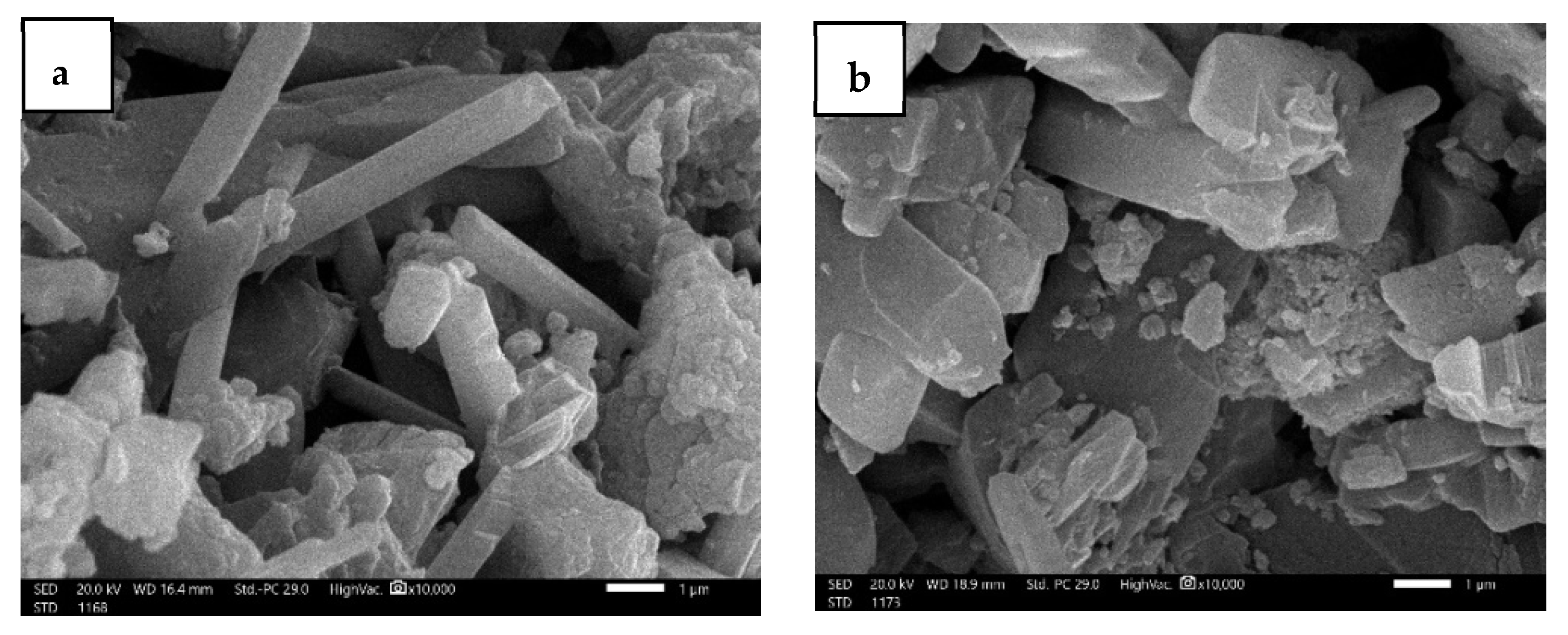
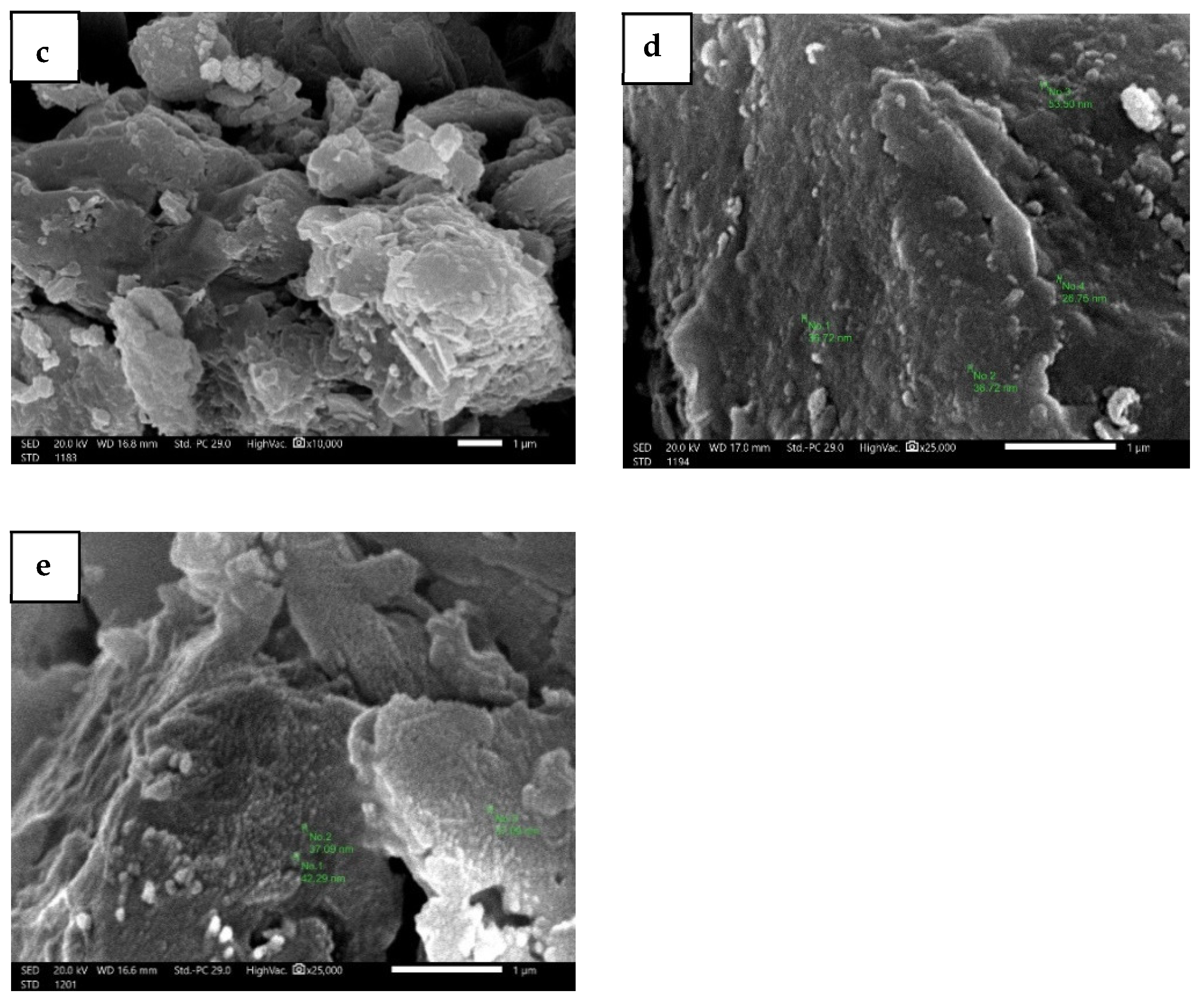
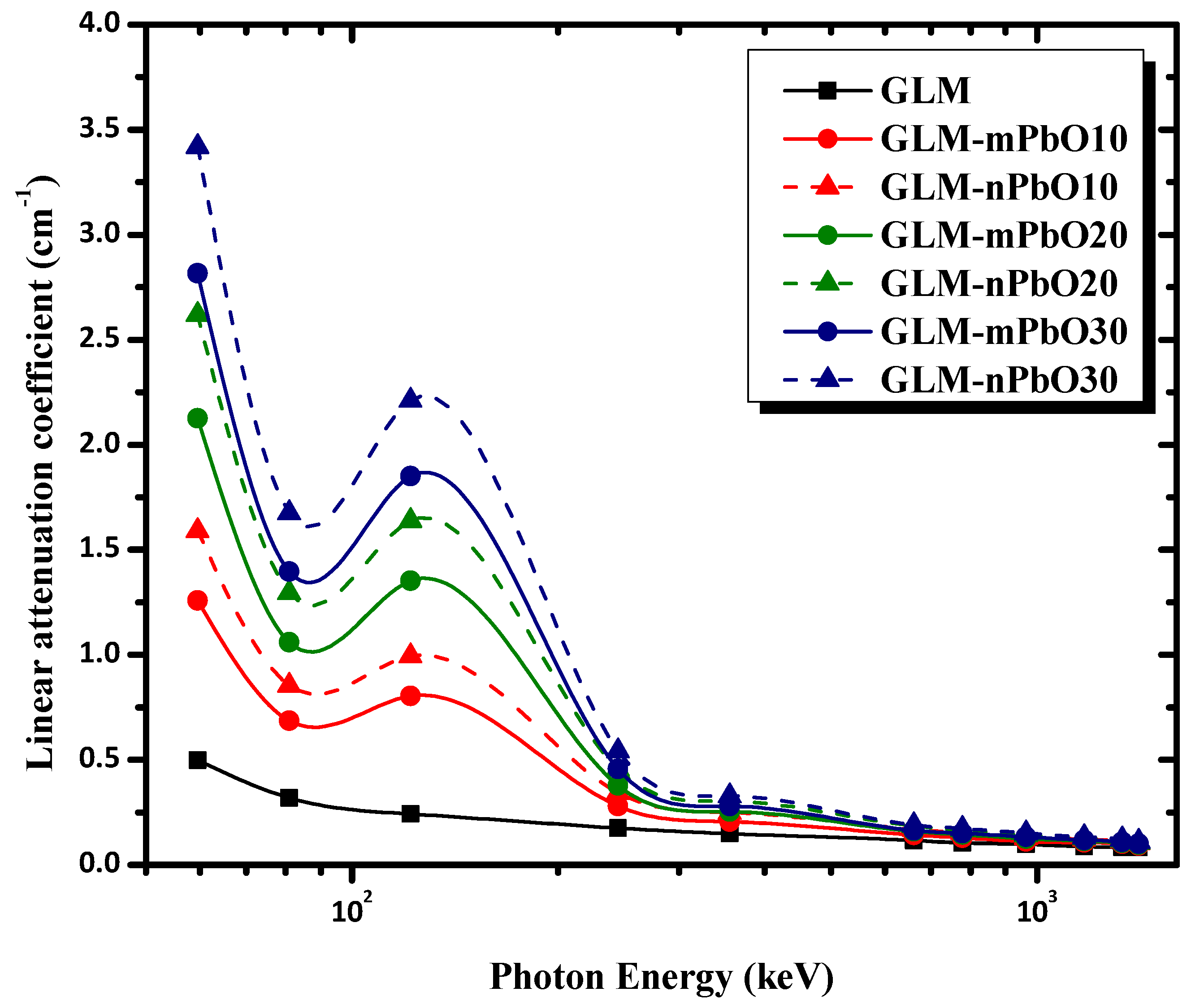
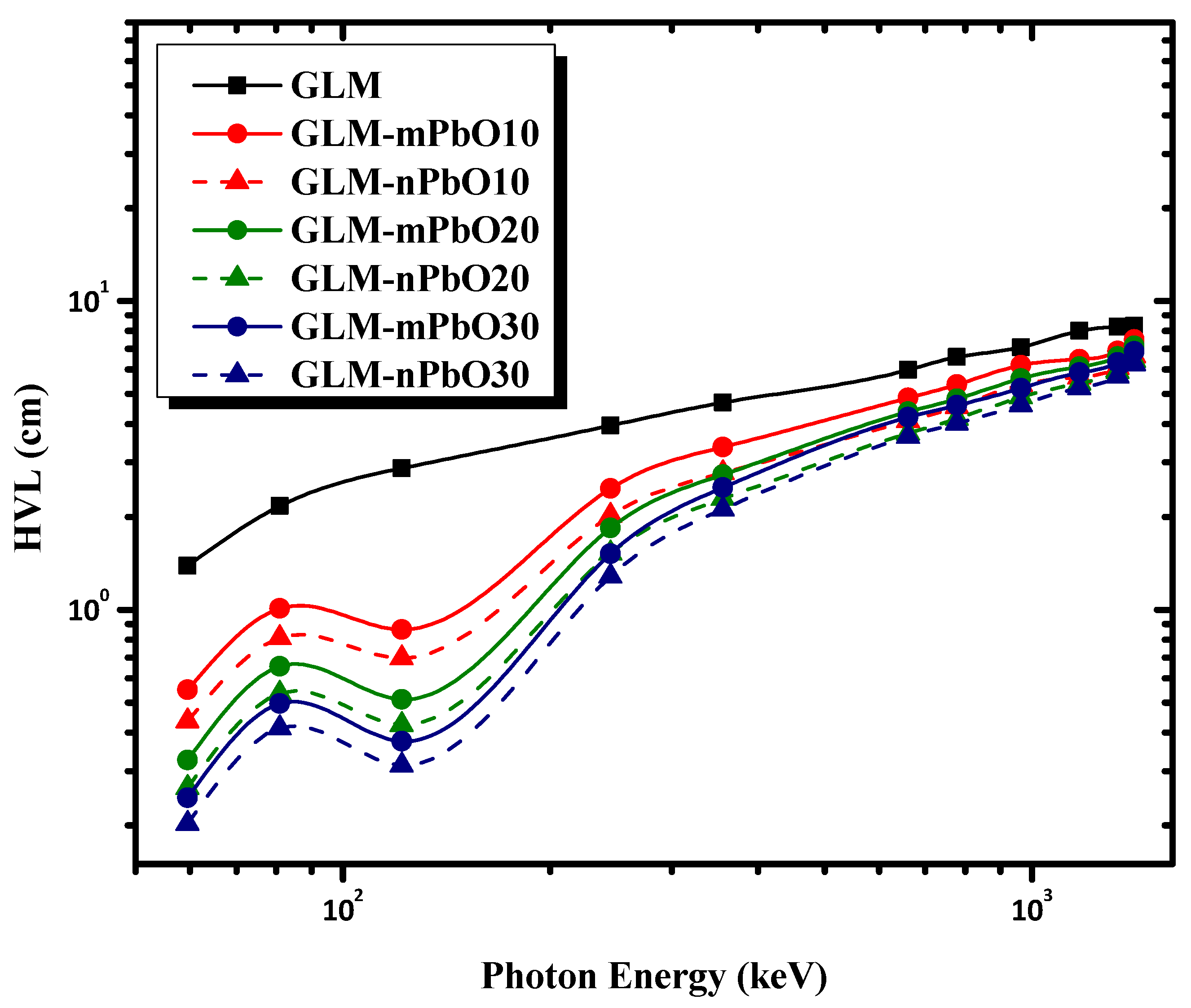
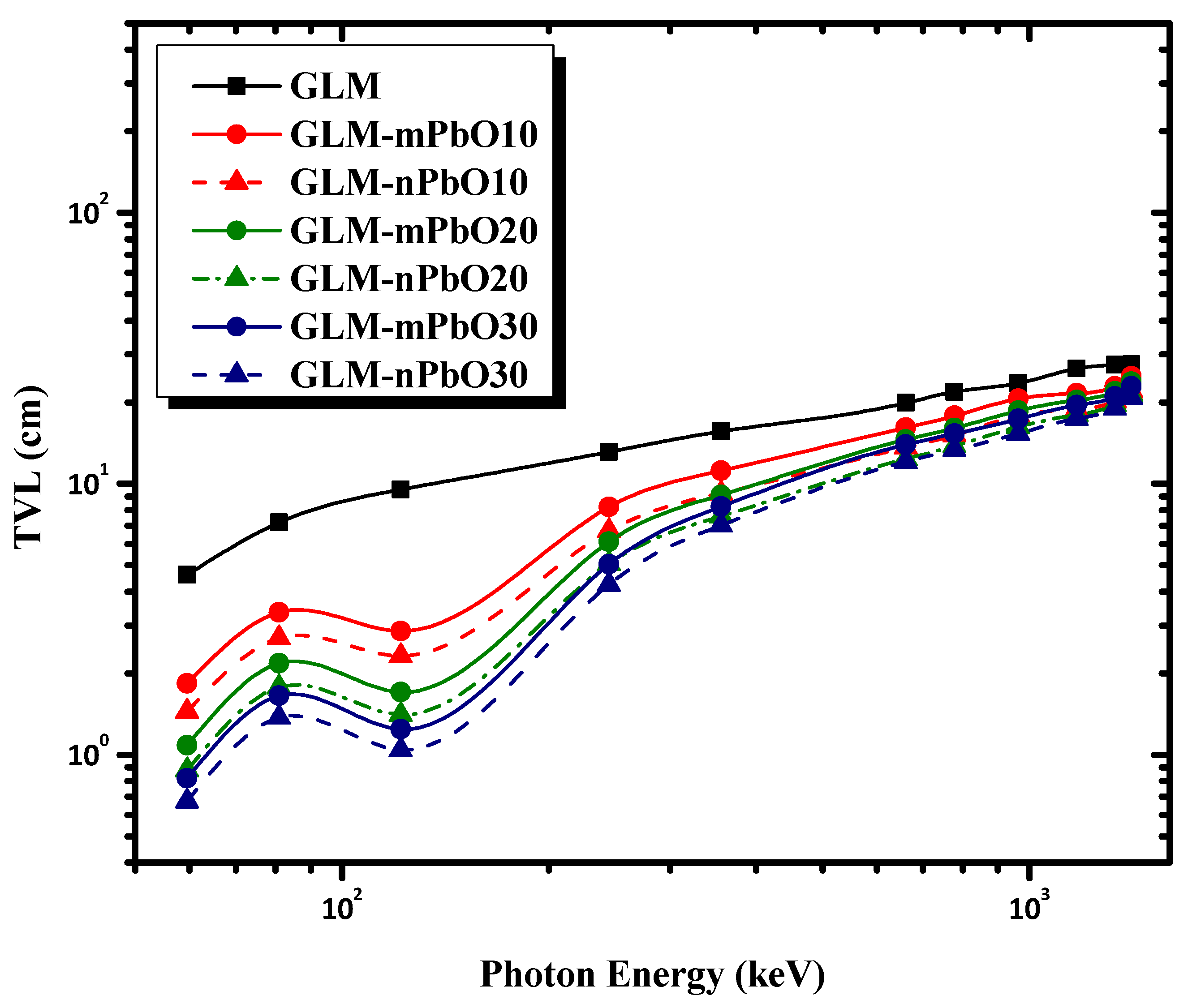
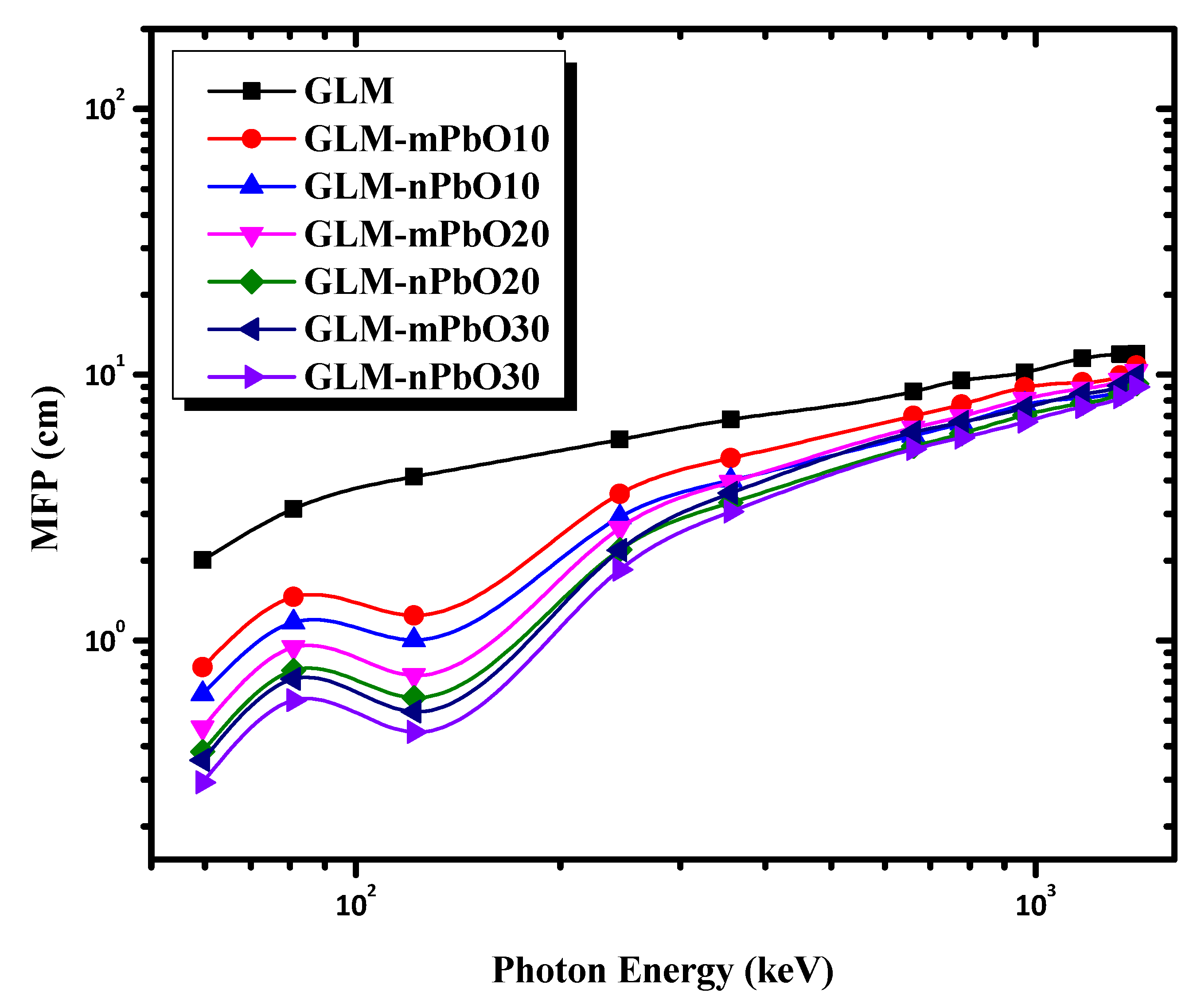
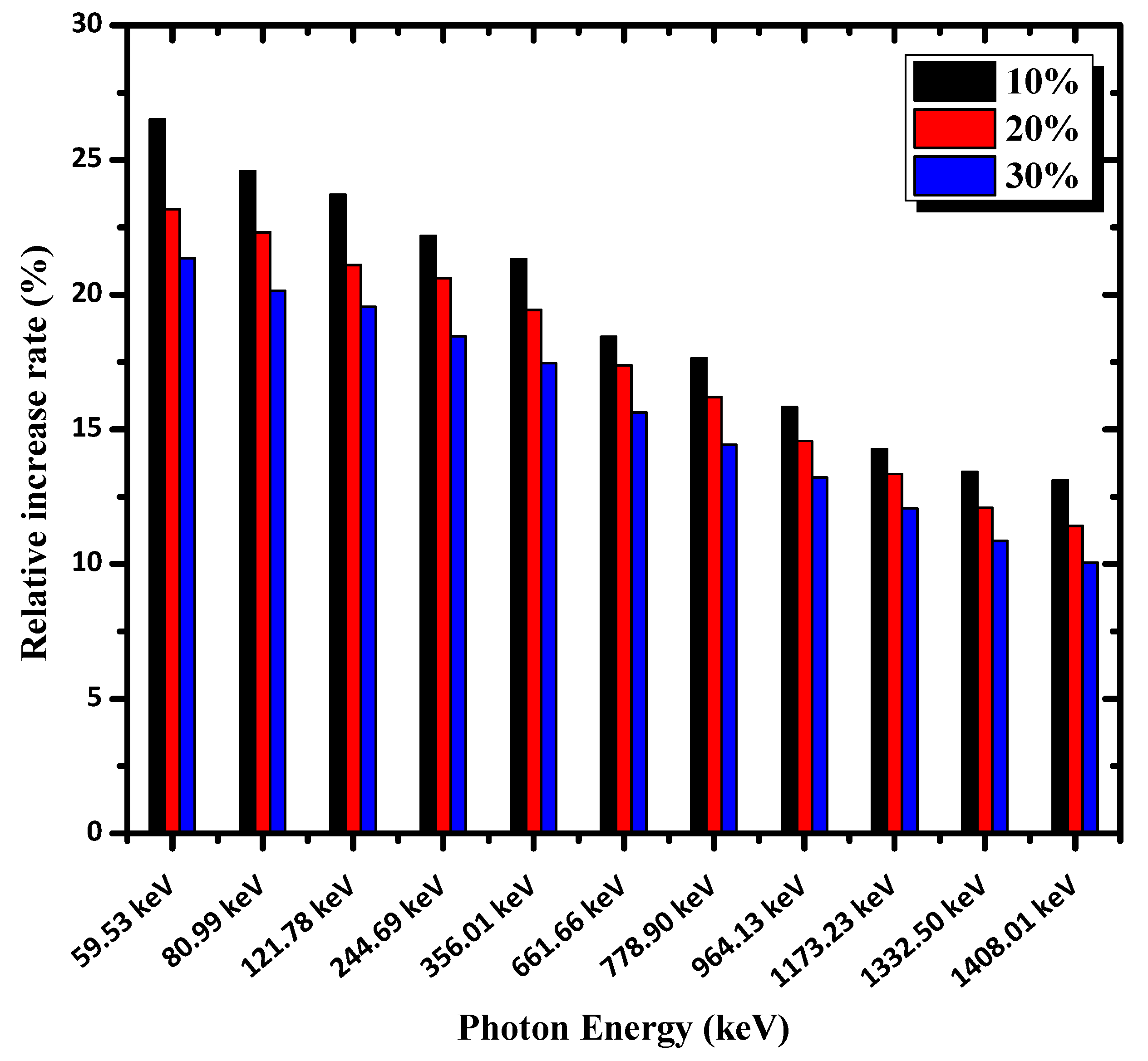
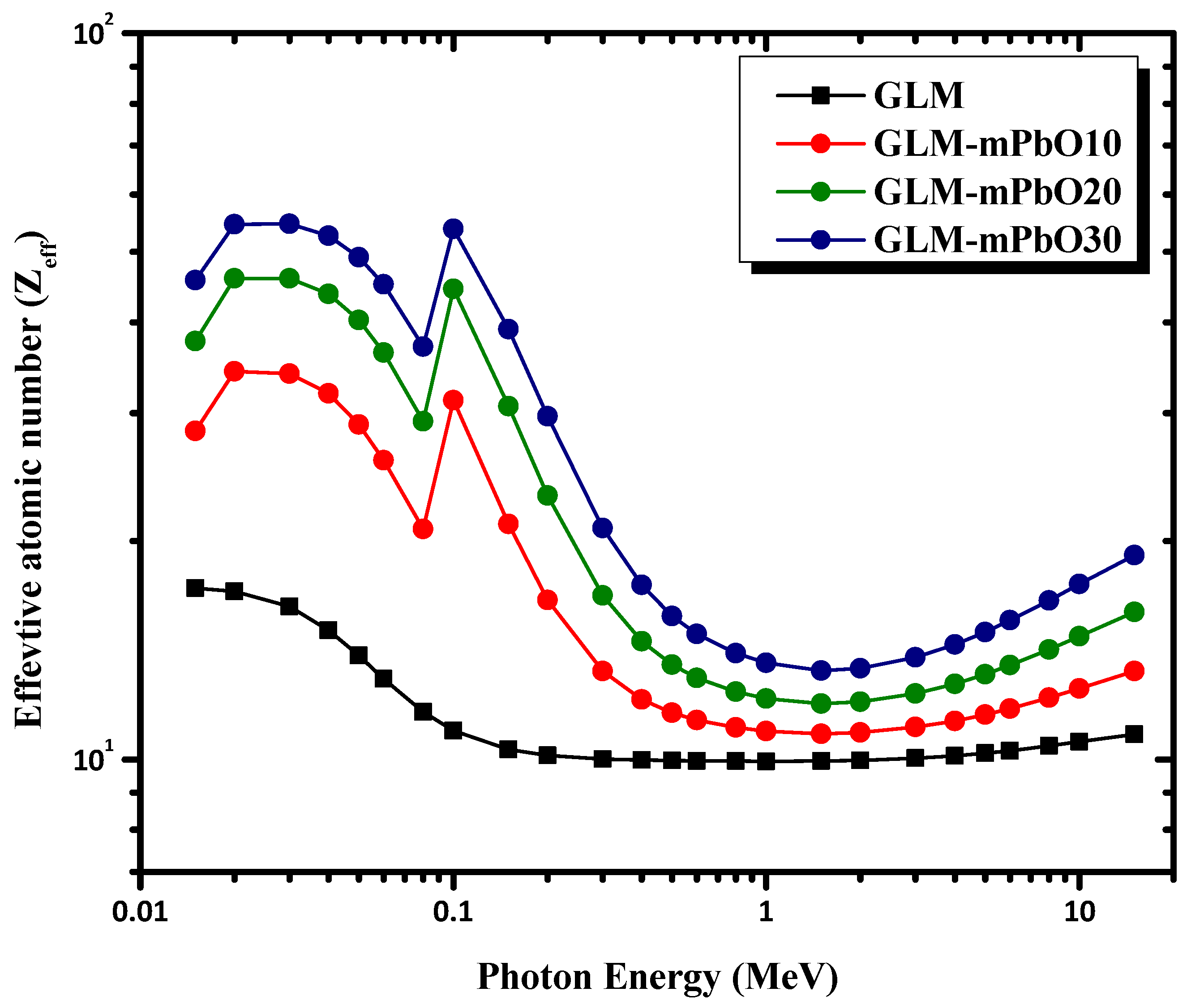
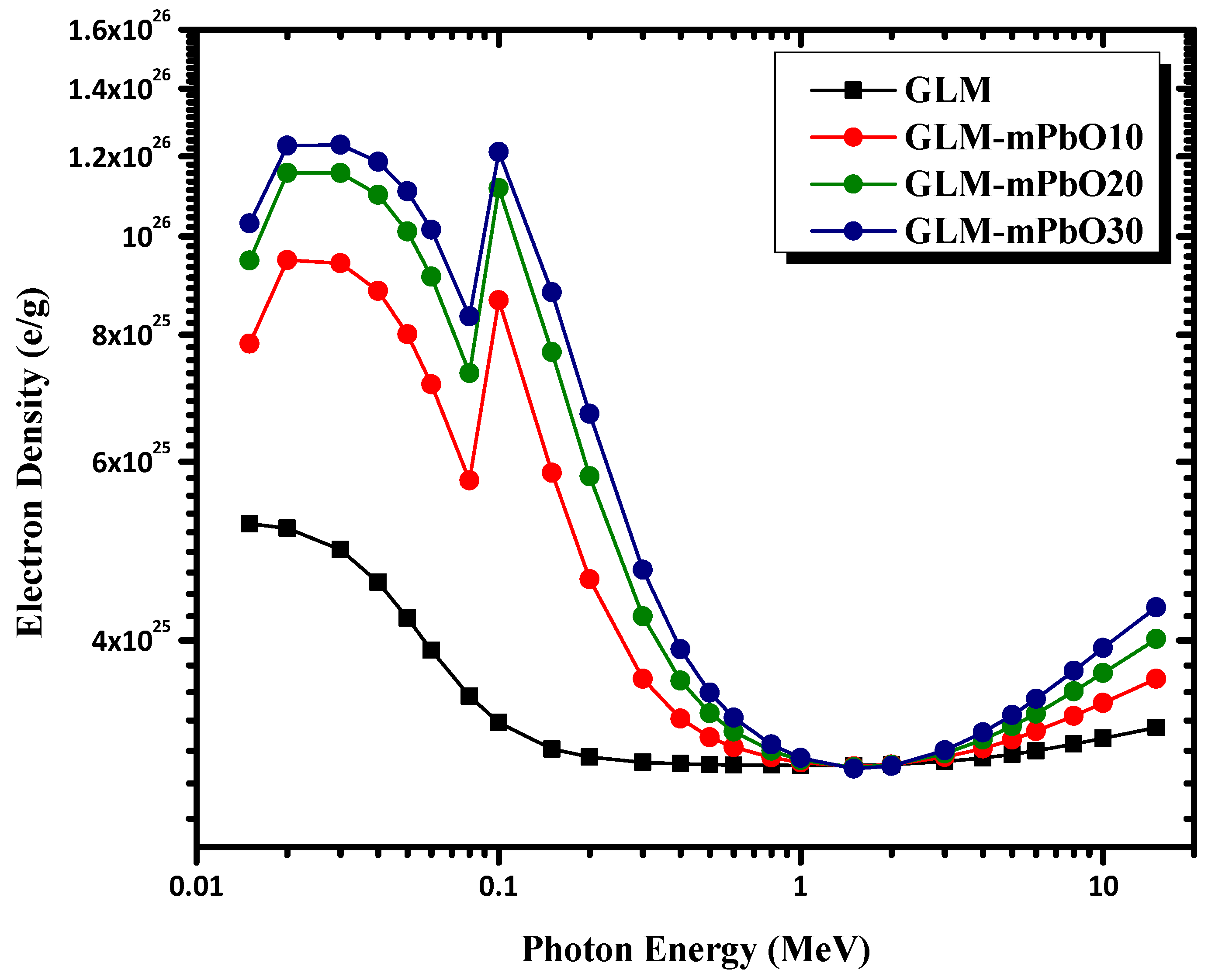

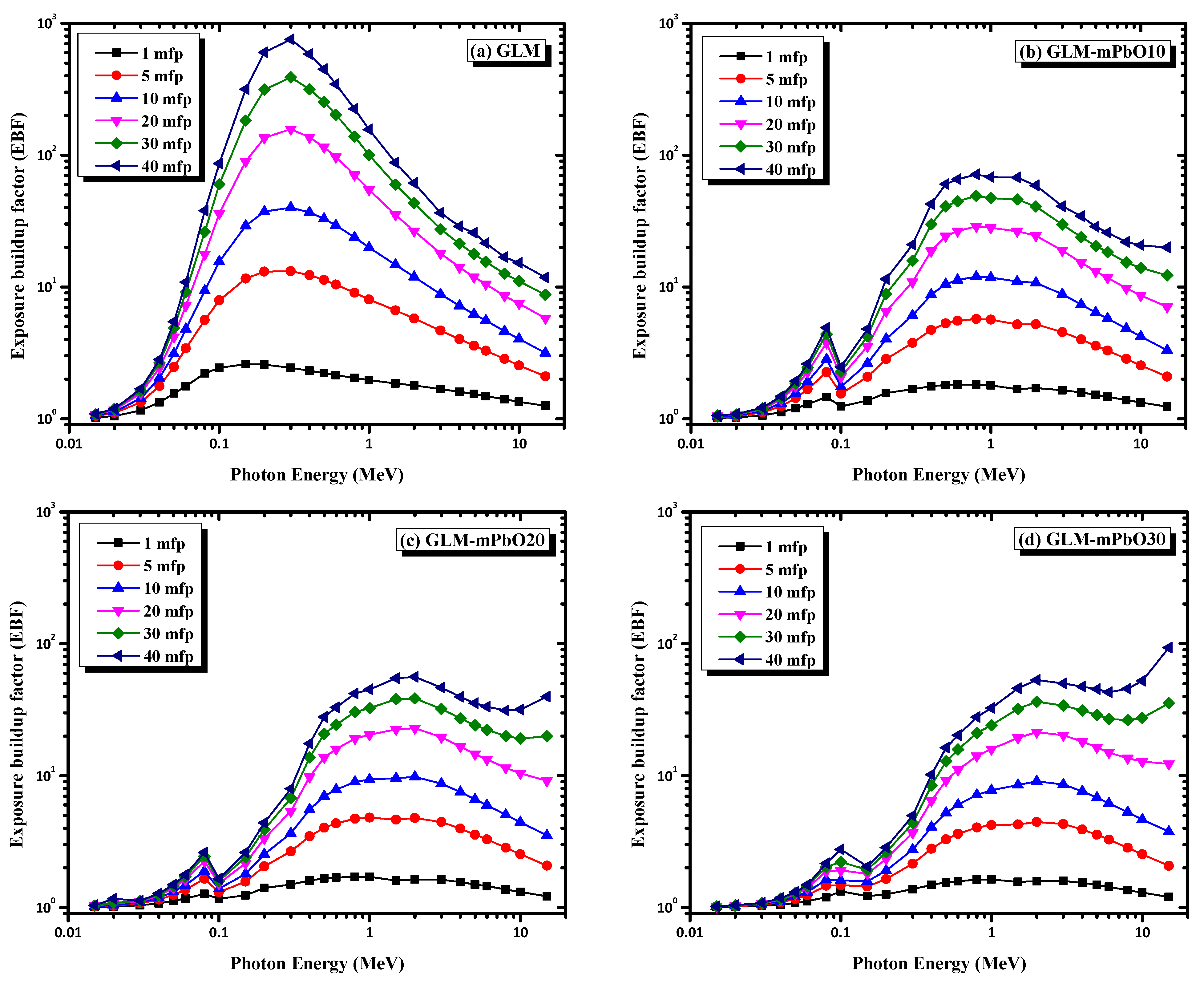
| Element | Chemical Composition (wt.%) | ||
|---|---|---|---|
| Gypsum | Lime | Waste Marble | |
| C | 3.80 ± 1.22 | 6.42 ± 0.35 | 11.54 ± 0.09 |
| O | 49.42 ± 0.21 | 51.56 ± 0.26 | 53.15 ± 0.53 |
| Al | - | - | 0.36 ± 0.15 |
| Si | - | 0.35 ± 0.19 | 0.70 ± 0.19 |
| S | 21.14 ± 0.73 | - | - |
| Ca | 25.65 ± 0.64 | 39.36 ± 0.21 | 34.04 ± 0.72 |
| Na | - | 0.34 ± 0.07 | - |
| Mg | - | 1 ± 0.03 | 0.21 ± 0.02 |
| Cl | - | 0.97 ± 0.12 | - |
| Sample Codes | Binder (1:0.2) | Aggregate | Water | ||
|---|---|---|---|---|---|
| Waste Marble | Micro-PbO | Nano-PbO | |||
| GLM | 1 | 2 | 0 | 0 | 0.5 |
| GLM-mPbO10 | 1 | 1.7 | 0.3 | - | |
| GLM-mPbO20 | 1 | 1.4 | 0.6 | - | |
| GLM-mPbO30 | 1 | 1.1 | 0.9 | - | |
| GLM-nPbO10 | 1 | 1.7 | - | 0.3 | |
| GLM-nPbO20 | 1 | 1.4 | - | 0.6 | |
| GLM-nPbO30 | 1 | 1.1 | - | 0.9 | |
| Nuclide | Energy (keV) |
|---|---|
| 241Am | 59.53 |
| 137Cs | 661.66 |
| 133Ba | 80.99 |
| 356.01 | |
| 60Co | 1173.23 |
| 1332.50 | |
| 152Eu | 121.78 |
| 244.69 | |
| 778.90 | |
| 964.13 | |
| 1408.01 |
| Sample | Energy (keV) | Density (g·cm−3) | MAC Micro PbO/GLM (cm2·g−1) | ||
|---|---|---|---|---|---|
| EXP. | XCOM | ∆% | |||
| GLM | 59.53 | 1.477 | 0.3378 | 0.3238 | 4.34% |
| 80.99 | 0.2166 | 0.2144 | 1.02% | ||
| 121.78 | 0.1634 | 0.1572 | 3.97% | ||
| 244.69 | 0.1188 | 0.1165 | 1.99% | ||
| 356.01 | 0.0999 | 0.1008 | -0.86% | ||
| 661.66 | 0.0783 | 0.0774 | 1.21% | ||
| 778.9 | 0.0713 | 0.07219 | −1.24% | ||
| 964.13 | 0.0663 | 0.06526 | 1.57% | ||
| 1173.23 | 0.0586 | 0.05923 | −1.01% | ||
| 1332.5 | 0.0567 | 0.05553 | 2.17% | ||
| 1408.01 | 0.0565 | 0.05397 | 4.62% | ||
| GLM-mPbO10 | 59.53 | 1.761 | 0.7142 | 0.7224 | −1.13% |
| 80.99 | 0.3892 | 0.3841 | 1.33% | ||
| 121.78 | 0.4567 | 0.4424 | 3.23% | ||
| 244.69 | 0.1593 | 0.1598 | −0.28% | ||
| 356.01 | 0.1168 | 0.1162 | 0.53% | ||
| 661.66 | 0.0811 | 0.08019 | 1.20% | ||
| 778.9 | 0.0734 | 0.07356 | −0.18% | ||
| 964.13 | 0.0634 | 0.06577 | −3.56% | ||
| 1173.23 | 0.0607 | 0.0593 | 2.37% | ||
| 1332.5 | 0.0571 | 0.05547 | 2.89% | ||
| 1408.01 | 0.0525 | 0.05389 | −2.63% | ||
| GLM-mPbO20 | 59.53 | 1.847 | 1.1514 | 1.121 | 2.71% |
| 80.99 | 0.5734 | 0.5538 | 3.54% | ||
| 121.78 | 0.7321 | 0.7276 | 0.62% | ||
| 244.69 | 0.2042 | 0.2032 | 0.48% | ||
| 356.01 | 0.1372 | 0.1315 | 4.37% | ||
| 661.66 | 0.0858 | 0.08264 | 3.78% | ||
| 778.9 | 0.0777 | 0.07494 | 3.67% | ||
| 964.13 | 0.0669 | 0.06628 | 0.96% | ||
| 1173.23 | 0.0612 | 0.05938 | 3.03% | ||
| 1332.5 | 0.0568 | 0.05541 | 2.50% | ||
| 1408.01 | 0.0525 | 0.05381 | −2.50% | ||
| GLM-mPbO30 | 59.53 | 1.948 | 1.4457 | 1.5200 | −4.89% |
| 80.99 | 0.7163 | 0.7234 | −0.99% | ||
| 121.78 | 0.9497 | 1.0130 | −6.25% | ||
| 244.69 | 0.2343 | 0.2465 | −4.93% | ||
| 356.01 | 0.1432 | 0.1469 | −2.50% | ||
| 661.66 | 0.0846 | 0.08509 | −0.58% | ||
| 778.9 | 0.0773 | 0.07631 | 1.31% | ||
| 964.13 | 0.0682 | 0.0668 | 2.13% | ||
| 1173.23 | 0.0606 | 0.05945 | 1.98% | ||
| 1332.5 | 0.0563 | 0.05535 | 1.65% | ||
| 1408.01 | 0.0517 | 0.05373 | −3.69% | ||
Disclaimer/Publisher’s Note: The statements, opinions and data contained in all publications are solely those of the individual author(s) and contributor(s) and not of MDPI and/or the editor(s). MDPI and/or the editor(s) disclaim responsibility for any injury to people or property resulting from any ideas, methods, instructions or products referred to in the content. |
© 2023 by the authors. Licensee MDPI, Basel, Switzerland. This article is an open access article distributed under the terms and conditions of the Creative Commons Attribution (CC BY) license (https://creativecommons.org/licenses/by/4.0/).
Share and Cite
Alabsy, M.T.; Gouda, M.M.; Abbas, M.I.; Al-Balawi, S.M.; El-Khatib, A.M. Enhancing the Gamma-Radiation-Shielding Properties of Gypsum–Lime–Waste Marble Mortars by Incorporating Micro- and Nano-PbO Particles. Materials 2023, 16, 1577. https://doi.org/10.3390/ma16041577
Alabsy MT, Gouda MM, Abbas MI, Al-Balawi SM, El-Khatib AM. Enhancing the Gamma-Radiation-Shielding Properties of Gypsum–Lime–Waste Marble Mortars by Incorporating Micro- and Nano-PbO Particles. Materials. 2023; 16(4):1577. https://doi.org/10.3390/ma16041577
Chicago/Turabian StyleAlabsy, Mahmoud T., Mona M. Gouda, Mahmoud I. Abbas, Shoaa Mofleh Al-Balawi, and Ahmed M. El-Khatib. 2023. "Enhancing the Gamma-Radiation-Shielding Properties of Gypsum–Lime–Waste Marble Mortars by Incorporating Micro- and Nano-PbO Particles" Materials 16, no. 4: 1577. https://doi.org/10.3390/ma16041577





